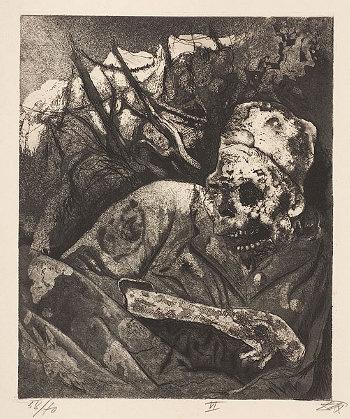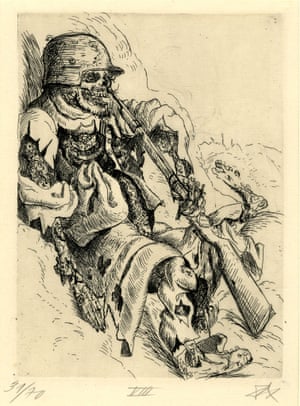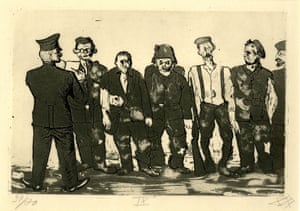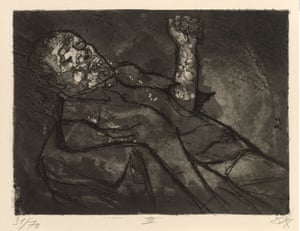| self portrait |
Otto Dix
German artist and Printmaker
Above is the Self Portait of Otto Dix, this print is very caricature like and I feel he looks stern and of importance with his expression. I'm not sure of his background and I'm really looking at the basic information with the work only.
Below is a print of a women (wife maybe) If you notice the softer appearance and more portrait like finish. I do like the bold hatching and marks left around the women's neck and chin. The contrast of light and dark work well without being to heavy. Closing my eyes slightly I like how the light in her hair and cheek bone flow and this makes the area jump out. I do believe this artist to have a real understanding of how the tonal value can change the feel of mood of an image. The top one I notice the marks are more thicker/harsher and charcoal like, while the bottom image is soft light and angled to show where the light hits the top of her head and face.
| mrs otto mueller |
These prints are a lot darker and I find myself wanting to know much more. The images create a sense of terror and doom. Many images are a black/dark background to set a mood or a feel of a long night. This must be a good way of creating a deadly or dark sinister mood. Like the colour red being of danger or warning.

 |
| I'm not sure if this is a bad copy, but it looks like pointillism Does the burr make this effect I wonder? |
The above 3 look very different to the below image. The above remind me of the goya prints I looked at last year.
 |
| goya print |

Here I noticed the the overlaying that gave greater marks to create dark/shade. You would of have to have studied and documented your finding to know which marks made what etc. The time in the acid and processes.
I think while we no longer do acid dipping and stuff, my own finding of doing etchings helps me appreciate the time and findings these artist have given.
I think I'd like to go back to doing a self portrait for my printmaking and try to do the different feels a mark can create. Last year I'd done the below images but while I was happy with the examples I dont think they gave a sense of eerieness. I think that by looking at Dix, Goya and Dores etching I could try and be more confident with my outcome.
 |
| my background has no texture of feels of anything, something to consider maybe |
I dont think by adding red as I did gave anything to my work! I now have a starting point and I'm excited to jump in to my finding. I think background helps to play a part in the overall look too.
Anyway more about artist.
I think Dix has really imersed himself into the stories of these horrors and tortures of gas and war. Many things were censored and wartime reporting was spared from its ghastly details. I don't think this artist could of just made up many of the details without researching the horrors. In a time that people were maybe
Erase that last bit............. upon reading the artist was in the war, as it turns out during the war, Dix kept a diary and a sketchbook with which he chronicled his experience. They provided material for a major work of fifty prints called simply, The War.
Dix was profoundly affected by the war. He described a recurring nightmare in which he crawled through bombed out houses. His experience with war and its aftermath became a dominant theme in the art he produced after 1914. He had before the war been an apprentice for an landscape painter and in these years I'm sure he knew the importance of drawing and sketching. I think for him the art would of been an escape and afterwards some kind of release. Powerful images and executed with a sense of calm amongst the chaotic stillness captured.




I enjoy how all these prints are so different but with each on as serious as the next, soldiers and men going to war, at war or dead.



No comments:
Post a Comment